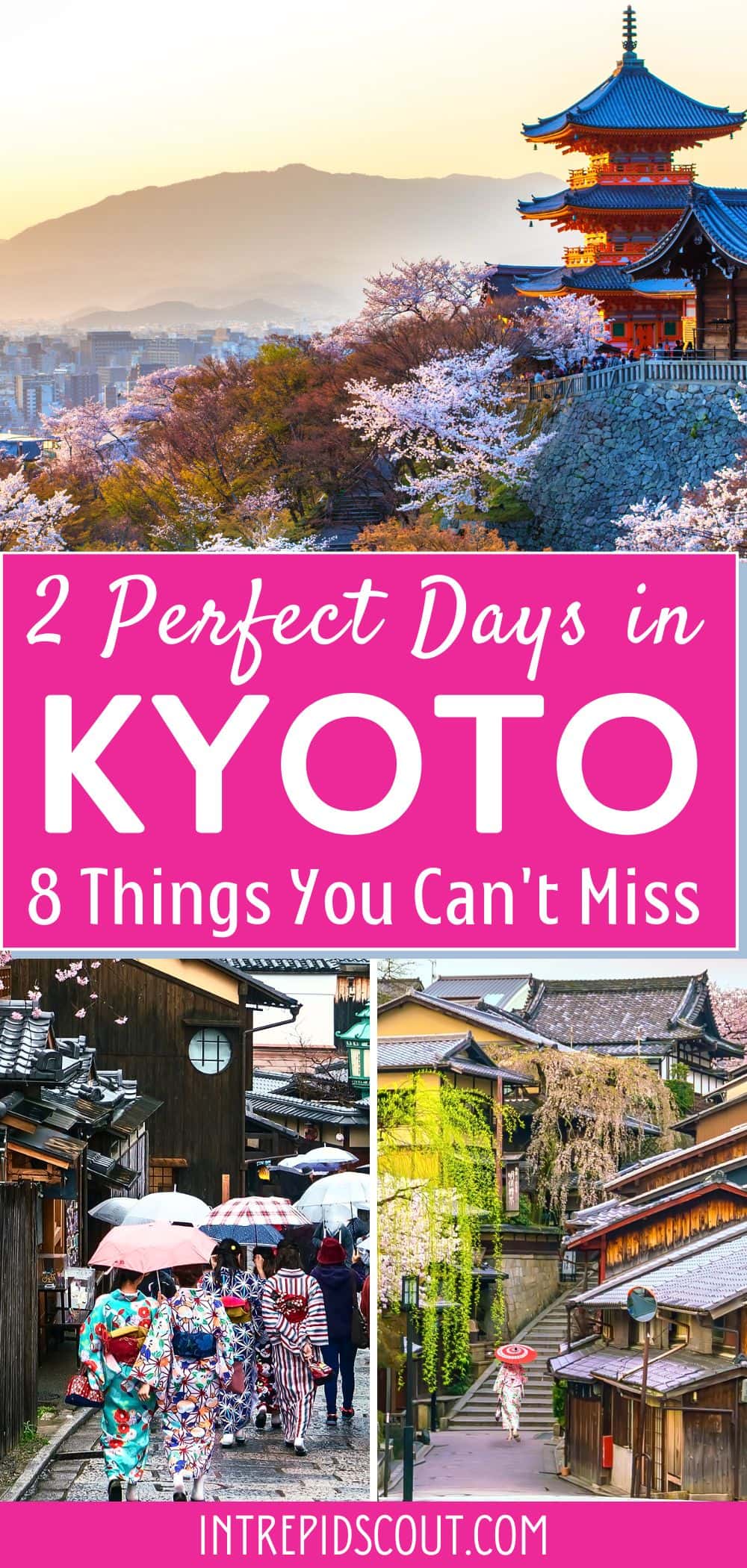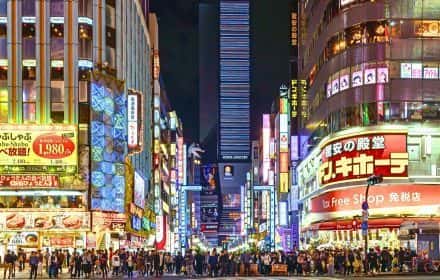This site uses affiliate links, meaning that if you make a purchase through our links, we may earn an affiliate commission.
Kyoto, located in West-central Honshu, in the valley of the Kamo River and surrounded by mountains, is one of the most historic and picturesque cities in Japan.
Much of its charm and beauty is preserved in its many historic temples and shrines, stunning gardens, and old wooden houses.
Follow this guide for the perfect 2 days in Kyoto itinerary that covers 8 major attractions in Kyoto!
If you have more than 2 days in Kyoto, then take a look at First Visit to Kyoto – How to Visit and What to See (11 Things You. Can’t Miss).
- 1. How to Get Around in Kyoto
- 2. Where to Stay in Kyoto
- 3. Best Time to Visit Kyoto
- 4. KYOTO - DAY 1
-
- 4.1. Nijo Castle
- 4.2. Golden Pavilion (Kinkaku-ji)
- 4.3. Arashiyama
- 4.4. Nishiki Market
- 5. KYOTO - DAY 2
-
- 5.1. Kiyomizu Temple
- 5.2. Sanjusangendo Temple
- 5.3. Fushimi Inari Taisha
- 5.4. Gion District
- 6. Intrepid Scout's Tips for 2 Days in Kyoto Itinerary
How to Get Around in Kyoto
Kyoto is super easy to explore by public transport. The buses, trains, and subways will get you fast to all the amazing places you can’t miss on your first visit to Kyoto. And, there are always several ways of getting to a particular place.
If you want to explore Kyoto at a leisurely pace, then, hands down, walking and bicycling are awesome ways to see all the top sights in Kyoto as well.
- Kyoto’s Trains
Kyoto has 6 train lines and consists of the national JR Line and several local private lines. If you have a JR Rail Pass, then you will definitely want to use JR trains while you are exploring Kyoto!
You can download a free English-language PDF of Kyoto’s train system here.
- Kyoto’s Subway System
The Kyoto subway system is composed of two lines: The north-south Karasuma Line and the east-west Tozai Line. These two lines intersect in the middle of Kyoto, allowing you to transfer lines.
Make sure to download a free English-language PDF of Kyoto’s subway system here to help you navigate Kyoto by the subway system.
- Kyoto’s Bus System
The bus system is extensive in Kyoto is extensive, and honesty, you can get almost anywhere by bus in Kyoto.
Download Kyoto’s bus system map with Kyoto’s major attractions here.
From personal experience, I think you will find trains and subways easier to use especially if this is your first visit to Kyoto. However, once to take a bus a couple of times, you will be quite comfortable using it.
- Walking and Bicycling
If you want to explore Kyoto at a leisurely pace, then what you need to know is Kyoto is a delightful city to explore on foot. It is completely flat and the weather is pleasant most of the year.
If you like bicycling then, you are for a treat! In my opinion, Kyoto is one of the world’s great bike cities. It is super easy to rent a bike in Kyoto and my recommendation is that you check out the Kyoto Cycling Tour Project for the best prices and best quality bikes.
Another great option is to book Kyoto Bike Tour. This tour is about 7-8 hours long (you will be biking for about 25 miles) and takes you to Bamboo Forest (Arashiyama), Kiyomizu, Golden Pavilion, and Fushimi Inari, plus you get to explore the Gion neighborhood.
- Book a Tour
If you are not comfortable using Kyoto’s public transportation, then my recommendation is to book a small group tour. 10 Must-See Spots in Kyoto One-Day Private Tour is a perfect tour if you only have one day in Kyoto and do not want the stress of figuring out the logistics of public transportation.
Where to Stay in Kyoto
- Downtown Kawaramachi
The best area to stay in Kyoto is Downtown Kawaramachi. It offers plenty of restaurants and shops, and to top it off, it is just a walking distance of Gion.
My favorite place to stay is Kyoto Shijo Takakura Hotel Grandereverie. The location is perfect right in the heart of Kyoto (0.6 miles from Gion Shijo Station and a 15-minute walk from Kyoto International Manga Museum).
You will love everything about this place. The staff is so accommodating and extremely polite. The cleanliness of the rooms is top-notch. The breakfast is yummy and healthy.
Another place that I want to recommend is Good Nature Hotel Kyoto. Again, great location: a 5-minute walk from Gion Shijo Station and 0.8 miles from Samurai Kembu Kyoto, 1.3 miles from Sanjusangen-do Temple, 1.4 miles from Kiyomizu-dera Temple, and 1.6 miles from TKP Garden City Kyoto.
Just an awesome hotel! You will love everything about it. The hotel is modern and beautifully designed. The rooms are super clean. The bedding and linens are always crisp and smell fresh. All the bath products are lovely and organic.
- Kyoto Station
Another excellent area to stay in Kyoto is anywhere around Kyoto Station. It is super convenient and all your public transportation options are in one spot.
The one place that I am recommending you check out is The Thousand Kyoto Hotel. The Thousand Kyoto Hotel is another one of my favorites! The location is awesome, with the absolute cleanliness, super comfy bed, and fresh, crisp linens, fabulous breakfast, professional staff that will go out of their way to make your stay comfortable, you cannot go wrong with booking this hotel.
- If Kyoto is fully booked, then start searching for hotels in Osaka. Kyoto is only less than an hour away from Osaka via train.
Best Time to Visit Kyoto
Kyoto is a great place to visit at any time of the year. The climate is temperate, which means that it does not get super hot or extremely cold.
- However, the best times to visit Kyoto are October/November (fall) and March/April/May (spring). Needless to say, the changing leaves in the fall are beautiful and the cherry blossoms in the spring are stunning.
- The summer months (June/July/August) in Kyoto can be hot and humid.
- The winter months (December/January/February) in Kyoto are usually fairly cold.
KYOTO - DAY 1
Nijo Castle
We start the 2 days in Kyoto itinerary with a visit to Nijo Castle.
It is super easy to get to Nijo Castle from Kyoto Station and you can use a bus, subway, or train. The easiest and most efficient way to get to Nijo Castle is to take a bus. You can take buses 101, 50, 111, or 9 and get off at Nijojo-mae. It will take you about 15-20 minutes to get to Nijo Castle.

Nijo Castle in Kyoto / 2 Days in Kyoto Itinerary
2 Days in Kyoto
Nijo Castle was built in 1603 and served as Tokugawa Ieyasu (1542-1616) shogunate center of power.
The stunning Karamon Gate leads to Nijo Castle. It was the symbol of authority. It proclaimed the prestige of the buildings located behind the gate.
Interestingly enough, the passage through Karamon Gate was reserved only for the shogun during his visits to the castle.
Karamon gate at Nijo Castle in Kyoto was constructed entirely of cypress bark in hip-and-gable fashion. The cypress bark would become dark brown color as it aged.
The ridges of the roof were adorned with ‘shachihoko’ – a traditional dolphin-like fish.
Under the roof were intricate wood sculptures depicting luan (a mythical Chinese bird), pine trees, peonies, clouds, and blades of grass.

Nijo Castle in Kyoto / 2 Days in Kyoto Itinerary
2 Days in Kyoto
As soon as you cross the gate, you will catch the sight of Ninomaru Palace. Its purpose was to impress the visitors, as well as, to intimidate them.
First of all, Ninomaru Palace consists of five connected buildings which were constructed with high-quality Hinoki cypress. Each building was lavishly decorated with gold leaf, wood carvings, and beautiful paintings created by the artists of Kano school.
Needless to say, this elaborate decor served to make the impression on the visitors and to re-confirm the power of the shoguns.
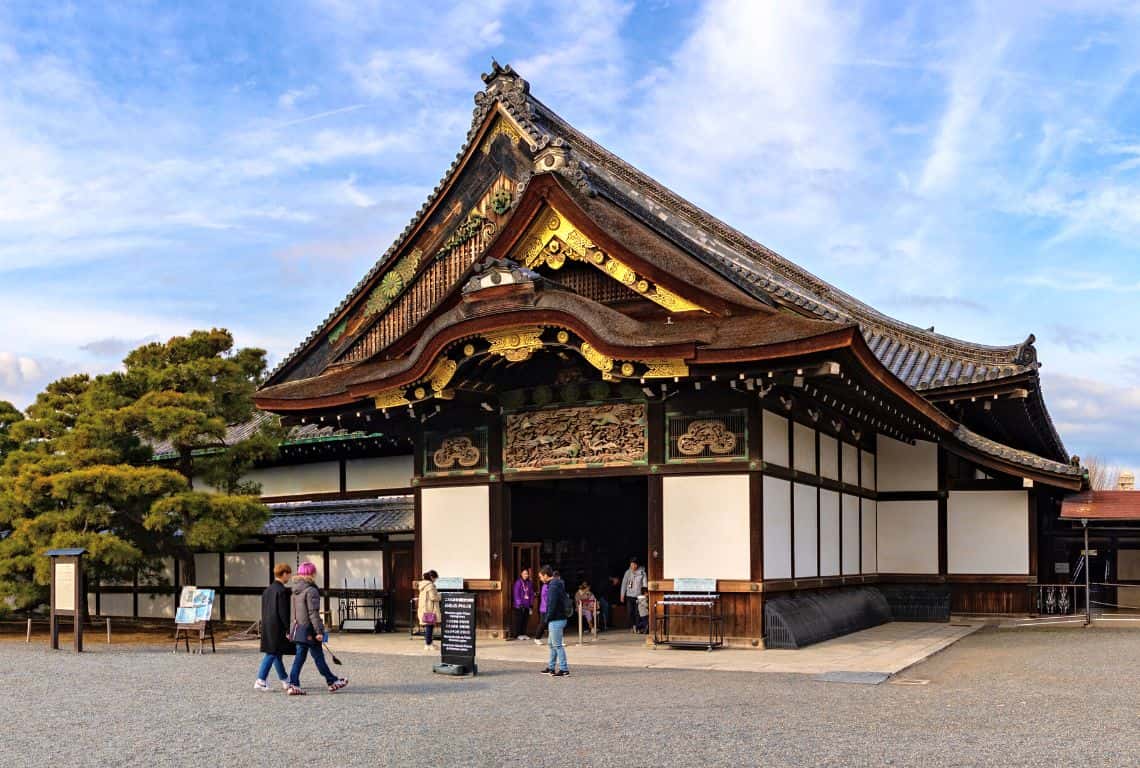
Nijo Castle in Kyoto / 2 Days in Kyoto Itinerary
2 Days in Kyoto
Golden Pavilion (Kinkaku-ji)
The next stop is the stunning Golden Pavilion (Kinkaku-ji).
The best way to get to Golden Pavilion from Nijo Castle is to hop on bus 101, 111, or 12 at Nijojo-mae bus stop B, located on the castle side of the road, and get off at Kinkakuji-michi bus stop.
All I have to say is that you will be in awe once you see the Golden Pavilion. It really is a sight out of this world! A temple covered in gold with a golden phoenix standing on top when the sun hits, the view is breathtaking!

Golden Pavilion in Kyoto / 2 Days in Kyoto Itinerary
2 Days in Kyoto
The pavilion has three floors, each with its very own architectural style.
At the very top of the Golden Pavilion sits the Phoenix.
In Japanese mythology since the mid-6th century, the Phoenix is called Hō-ō. The Phoenix, or a sunbird brings goodwill as it descends from the heavens. It is, also, symbolic of an imperial household.

Golden Pavilion in Kyoto / 2 Days in Kyoto Itinerary
2 Days in Kyoto
You might be wondering if the Golden Pavilion Temple in Kyoto is covered in real gold. Yes! It is real gold!
The second and third stories of Golden Pavilion have approximately 48 kilograms of gold!
All this gold is maintained by a single person, Takesato Yagyu.
It is truly fascinating how Yagyu maintains the Golden Pavilion. Find out all the details here.
Arashiyama
The next stop on the 2 days in Kyoto itinerary is Arashiyama.
To get to Arqshiyama from the Golden Pavilion take bus 204 or 205 from Kinkakuji-michi Bus Stop B and get off at Nishinokyo-Enmachi. Next, take JR (Sagano line) from Enmachi Station to Arashiyama.
Arashiyama is a beautiful area located on the western outskirts of Kyoto and you could easily spend an entire day exploring Arashiyama.
One of the most popular things to do in Arashiyama is to take a walk through Arashiyama Bamboo Grove. It is a beautiful and peaceful bamboo forest and it looks absolutely amazing if there is a bit of sunlight filtering through the tall bamboo trees or if there is some light breeze that will make the stalks gently sway and let in the dappled light.
If you like photography, then this is the place to go! You will have a lot of fun taking pictures of this place.
My recommendation is to book an Arashiyama Rickshaw Tour. This tour will take you through Bamboo Grove and some of the most scenic and historic districts in Arashiyama.

Arashiyama Bamboo Grove in Kyoto / 2 Days in Kyoto Itinerary
2 Days in Kyoto
Arashiyama’s most iconic landmark is the wooden Togetsukyo Bridge. It is located no more than 10-15 minutes going south of Bamboo Grove.
Some sources claim that the Togetsukyo bridge spans the Katsura River. And, some sources say that it goes over the Oi River.
So, to clarify, the river is referred to as the Oi River until it reaches Togetsukyo Bridge. After it passes under the bridge, it is referred to as the Katsura River.
It is believed that the bridge was built in 836 AD when the priest Dosho (a disciple of Kobo Daishi, founder of the Shingon sect of Buddhism) was conducting construction work along the Oi River.
Togetsukyo Bridge is also known as the Moon Crossing Bridge after Emperor Kameyama stated that the bridge appeared to stretch to the moon.

Togetsukyo Bridge in Arashiyama / 2 Days in Kyoto Itinerary
2 Days in Kyoto
There is so much more to do in Arashiyama and it all depends on what you like to do. Make sure to check out the complete list of things to do in Arashiyama: 14 Amazing Things to Do in Arashiyama.
When you cross the Togetsukyo Bridge turn right and you will see a sign for Iwatayama Monkey Park.
First of all, what you need to know, is that the hike up to the park is fairly strenuous. It is pretty much up the hill hike at a steady incline.
It will take you about 25-30 minutes to reach the top of the mountain where Iwatayama Monkey Park is located.
If you want to feed the monkeys, you can purchase some food for them at the small shop located at the entrance to the park.

Iwatayama Monkey Park in Arashiyama / 2 Days in Kyoto itinerary
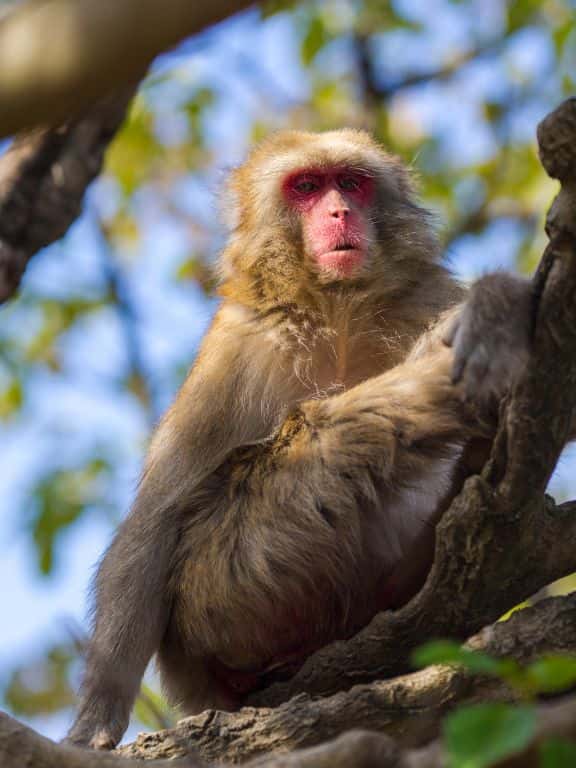
Iwatayama Monkey Park in Arashiyama / 2 Days in Kyoto itinerary
There is so much more to do in Arashiyama and it all depends on what you like to do. Make sure to check out the complete list of things to do in Arashiyama: 14 Amazing Things to Do in Arashiyama.
Nishiki Market
The next and last stop of the first day of the 2 days in Kyoto Itinerary is at Nishiki Market. The best and most efficient way to get to Nishiki Market from Arashiyama is to take board Nishikyogoku Train on Hakyu Railways (not covered by JR Pass) and get off at Kyoto-Kawaramachi. The journey takes no more than 15 minutes.
Nishiki Market usually starts to get pretty busy at around 5 pm and the best time to go is at 6 pm when all the stalls are operating at full steam and all the vendors are either cooking or trying to sell you different food samples.
Nishiki Market in Kyoto / 2 Days in Kyoto

Nishiki Market in Kyoto / 2 Days in Kyoto Itinerary
2 Days in Kyoto
The market is a narrow covered street that stretches for five blocks and houses over a hundred shops and restaurants.
The market is known as ‘Kyoto’s Kitchen’ and you will find here many Japanese delicacies, as well as everything food-related like knives and cookware.
Nishiki Market is always packed with tourists and locals alike. It is a fun place to just browse through and try a few items. Most of the food items are in small bite-side portions displayed on wooden sticks that you can just grab and eat on the spot.
What should you try? My recommendation is to definitely try these items:
- First of all, make sure to try tako-tamago, which means octopus-egg. It is a baby octopus marinated and cooked in a sauce made of sugar, mirin, and soy sauce. In the head of the octopus is a quail’s egg.
- Another recommendation is to try tamagoyaki, which I would describe as a Japanese type of omelet filled with cooked cabbage, carrot, green and white onions, and pickled ginger.
- Finally, try matcha warabi mochi from Kyoto Matcha Sweets Sawawa. These are square jellies made with green tea and powdered with matcha green tea.

Nishiki Market in Kyoto / 2 Days in Kyoto itinerary
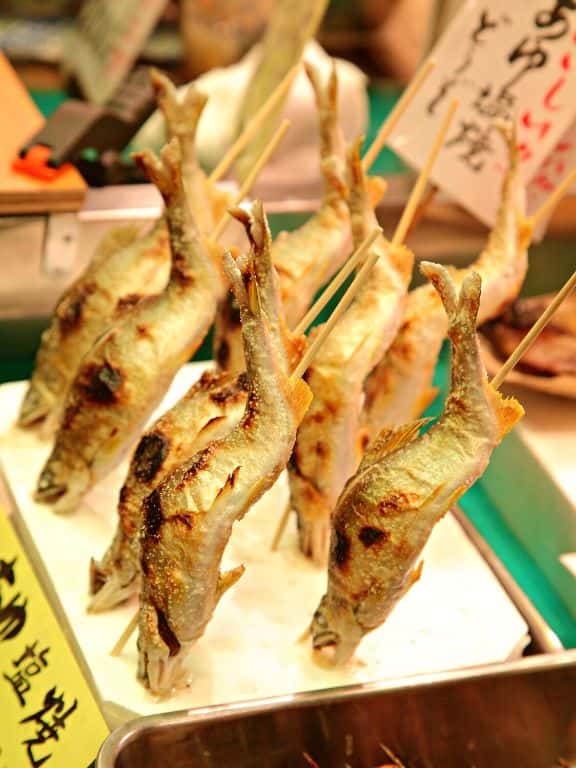
Nishiki Market in Kyoto / 2 Days in Kyoto itinerary
If you are not brave to try these items or need help navigating between stalls and restaurants at Nishiki Market then, look into some of the small group guided walking tours through Nishiki Market. You will be accompanied by a local guide who is usually an excellent resource on what are the best places to try some of the local delicacies.
Check out Nishiki Market and Gion District Cultural Walking Food Tour. This tour will take you not only around Nishiki Market but also into Gion.
Another tour that is less expensive, shorter, and just focuses on Nishiki Market is Nishiki Market Walking Food Tour where you get to try a variety of different foods.
The visit to Nishiki Market concludes the first day of the 2 days in Kyoto itinerary. Make sure to keep reading to the end of this post and find out how to get around in Kyoto as well as where to stay in Kyoto.
KYOTO - DAY 2
Kiyomizu Temple
We are going to start the second day of the 2 days in Kyoto itinerary by visiting Kiyomizu-dera.
As I mentioned at the beginning of this post, each day you will begin your itinerary at Kyoto Station. It is a perfect location to catch all the trains and buses as well as the subway.
To get to Kiyomizu-dera from Kyoto Station, take the JR Nara line train, and at the next station Tofukuji transfer to Keihan Railway and get off at Kiyomizu-Gojo station (the second station from Tofukuji).
Kiyomizu Temple, the ‘Temple of the Pure Water Spring’ is famous for its impressive viewing platform, three-story Koyasu pagoda, and the medicinal pure waters of the Otowa Spring.
The temple belongs to the Buddhist Kita-Hosso sect and was founded in 778 CE by Enchin Shonin.
Enchin Shonin, a priest from Nara, claimed to have received a vision that directed him to the exact location of a healing Otowa spring.
There is a belief that the waters of the spring have magical properties and each branch of the spring is associated with health, longevity, and exam success.
If you are tempted to drink some of the healing waters, then keep in mind that in order for the magical powers to be effective, you can only choose to drink from one branch of the stream.
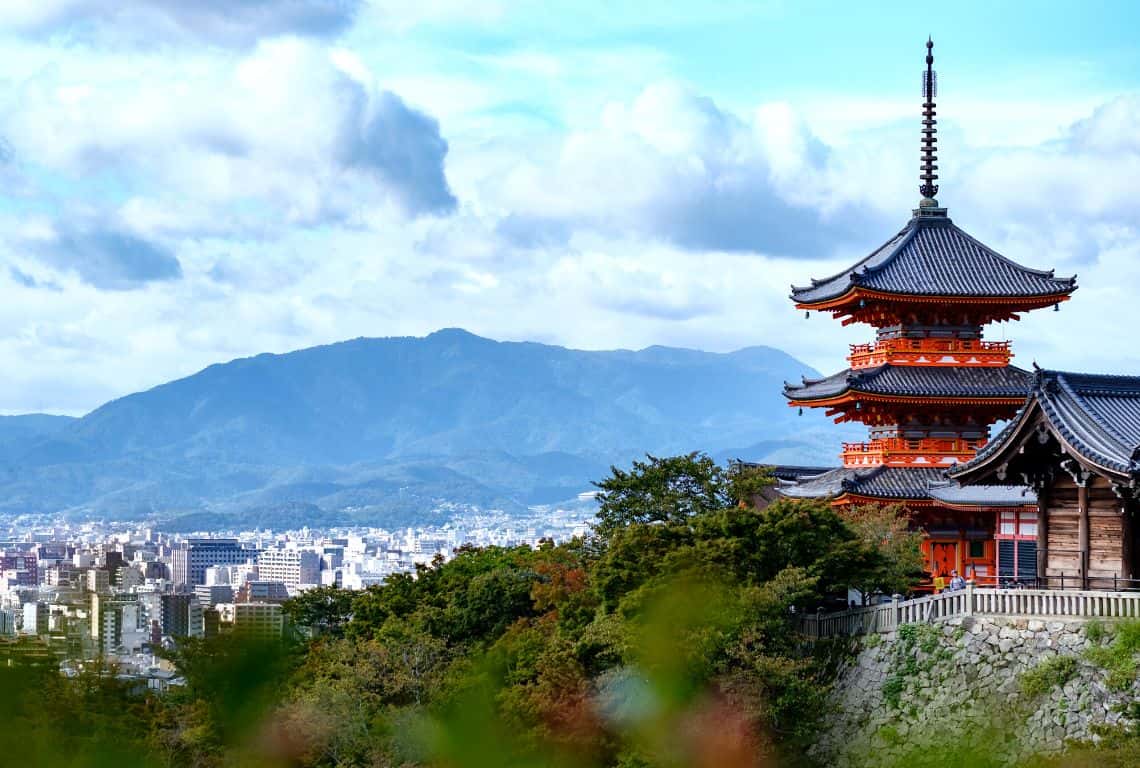
Kiyomizu Temple in Kyoto / 2 Days in Kyoto Itinerary
2 Days in Kyoto

Kiyomizu Temple in Kyoto / 2 Days in Kyoto Itinerary
2 Days in Kyoto
The temple grounds are especially beautiful if you are visiting during the spring months and the cherry trees are in full bloom, or during the fall months when the maple leaves turn into amazing burnt red and orange colors.
Sanjusangendo Temple
The next stop is Sanjusangendo Temple.
If the day is nice then I am recommending that you walk from Kiyomizu-dera to Sanjusangendo. It is about a 20-minute walk. If you do not feel like walking then take bus 202 from Kiyomizumichi. and get off at Higashiyama Nanajo.
Sanjusangendo Temple is famous for its long hodo – the main hall dating to 1266 and designated a National Treasure of Japan, and the collection of sculptures it houses.
The sculptures include 1001 standing Thousand-armed Kannon, 28 standing attendants, a statue of Fūjin, and a statue of Raijin, as well as the main image of the temple, a big seated statue of Thousand-armed Kannon. Most of the sculptures date to the Heian to Kamakura periods.
Unfortunately, pictures inside the main hall are not allowed. Here are a couple of pictures from Wikimedia Commons.
2 Days in Kyoto
On the second Sunday of January, the temple has an event known as the Rite of the Willow, where worshippers are touched on the head with a sacred willow branch to cure and prevent headaches.
Also, the Festival of the Great Target, is held on the west veranda where archers shoot arrows into targets. The festival known as the Toshiya dates back to the Edo period and was an archery exhibition contest.
Fushimi Inari Taisha
Right after visiting Sanjusangento, we are heading to Fushimi Inari Shrine. It is one of the most spectacular places in Kyoto.
To get to Fushimi Inari from Sanjusangendo, simply hop on JR Nara and you will be there in no more than 30 minutes.
Make sure to use your JR Pass for this ride. If you do not have a JR Pass, buy it before going to Japan. You will save a ton of money. You can buy JR Pass here.
Just a caution here: several express trains are operating on the JR Nara Line and these trains do not stop at Inari Station. So, make sure to board the train marked Nara.
When you arrive at the station, you will immediately notice the vermillion-painted columns all over the platform to replicate the torii gates and know that you are at the right place.
If you are like me, then you will be stopping at every turn and taking a lot of pictures. This place is a photographer’s dream come true!
You might look into Fushimi Inari Hidden Hiking Tour. It is a guided hike that will take you through some hidden secret trails around Inari Mountain.

Fushimi Inari Taisha in Kyoto / 2 Days in Kyoto Itinerary
2 Days in Kyoto
Fushimi Inari-Taisha Shrine is world-famous for its Torii (Gates).
It is said that there are over 10,000 Torii at Fushimi Inari. However, some sources claim that the number of Torii at Fushimi Inari is closer to 30,000.

Fushimi Inari Taisha in Kyoto / 2 Days in Kyoto Itinerary

Fushimi Inari Taisha in Kyoto / 2 Days in Kyoto Itinerary
One of the things that you need to do at Fushimi Inari Taisha is a hike to the top of Inari Mountain.
It is a great hike that winds around the mountain. It is visually stunning and gives you plenty of opportunities to get some awesome pictures!
Gion District
Once you are done exploring Fushimi Inari Taisha, head to the Gion District. The best way to get to the Gion area from Fushimi Inari is by Keihan Railway. It will take you about 20 minutes to get to Gion.
Gion District in Kyoto originates from the Sengoku period (1467–1615). The district was built to accommodate visitors to Yasaka Shrine (Gion Shrine).
It eventually evolved to become one of the most exclusive and well-known geisha districts in all of Japan.
The geisha in Kyoto do not refer to themselves as geisha, instead, they use the local term ‘geiko’ which means “a woman of art”.
The area is definitely worth visiting since it has preserved its traditional architecture. It is still inhabited and alive with shops and restaurants.
The best time to visit the Gion District is definitely in the evening. The narrow streets illuminated by the street lights have a very special charm. If you are lucky, you. might catch glimpse of geiko rushing to an evening engagement. Above all, you will have the place pretty much to yourself and you will be able to get some cool pictures.
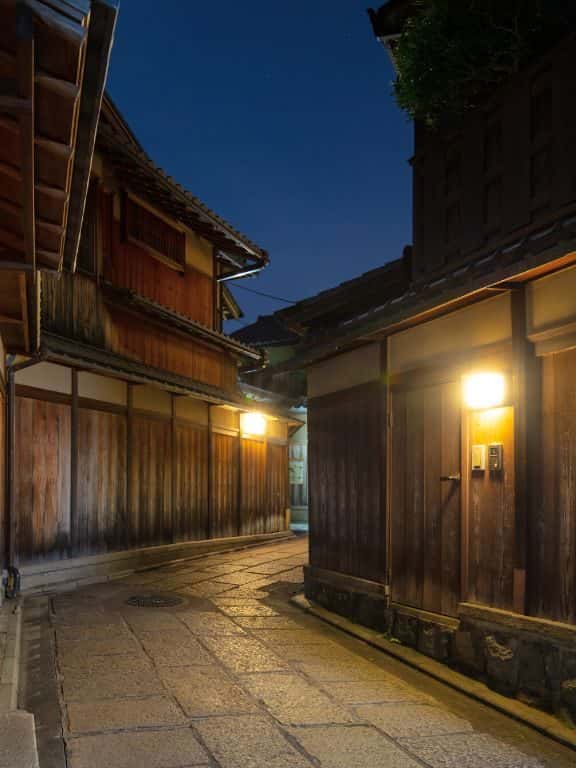
Gion District in Kyoto / 2 Days in Kyoto Itinerary

Gion District in Kyoto / 2 Days in Kyoto Itinerary
Beautiful Cherry Blossoms Along Takase River in Kyoto / 2 Days in Kyoto
There are many great restaurants in the Gion Area. ranging from cheap eats to expensive venues. My recommendation is to book a private or small group guided tour that will take you through the maze of narrow streets, plus you will get to sample some local food.
Check out: Nighttime All-Inclusive Local Eats and Streets, Gion and Beyond.
Intrepid Scout's Tips for 2 Days in Kyoto Itinerary
That is quite a list of things to do in Kyoto in 2 days. What if you only have time to see a couple of things? Then, my recommendation is to make sure that on your first visit to Kyoto you do not miss:
- Fushimi Inari Tashia – it is a visually stunning place. You will be in awe and you will be taking hundreds of pictures at every corner.
Make sure to check out my detailed post: Amazing Fushimi Inari in Kyoto (8 Things to Know Before You Visit)
- Golden Pavilion – it is definitely a stunning sight to see a pavilion covered in gold.
Here is a post that you need to read before going: Stunning Golden Pavilion in Kyoto (How to Visit and What to See)
- Nishiki Market – it is a great place to sample some local delicacies.
My recommendation is to look into a small group tour with a local guide. They know what stalls and restaurants to visit and what foods to try. Check out this guided tour that takes you around Nishiki Market: Nishiki Market Walking Tour.
Final thoughts: Japan is absolutely stunning when the cherry blossoms are in full bloom and during fall when the leaves are changing colors. So, for your perfect Instagram posts check out these quotes and captions about cherry blossoms and changing leaves:
Now, It Is Your Turn, I Would Like to Hear Back from You!
Are you planning your trip to Kyoto?
Please let me know! Drop me a quick comment right below!
Click on any of the images below to get inspired and to help you with the planning process for your trip to Kyoto!
More Information About Japan:
14 Amazing Things to Do in Arashiyama (Map+Useful Tips)
What to See at Nijo Castle in Kyoto (10 Top Things to Know)
Stunning Golden Pavilion in Kyoto (How to Visit and What to See)
Amazing Fushimi Inari Taisha in Kyoto (8 Things to Know Before You Visit)
First Visit to Kyoto – How to Visit and What to See (11 Things You Can’t Miss)
Perfect Day Trip to Miyajima from Kyoto, Osaka, or Hiroshima
10 Amazing Things to Do in Hiroshima You Can’t Miss of Your Visit
Did You Find 2 Days in Kyoto: The Perfect Kyoto Itinerary Useful?
Why Not Save It to Your Pinterest Board!

